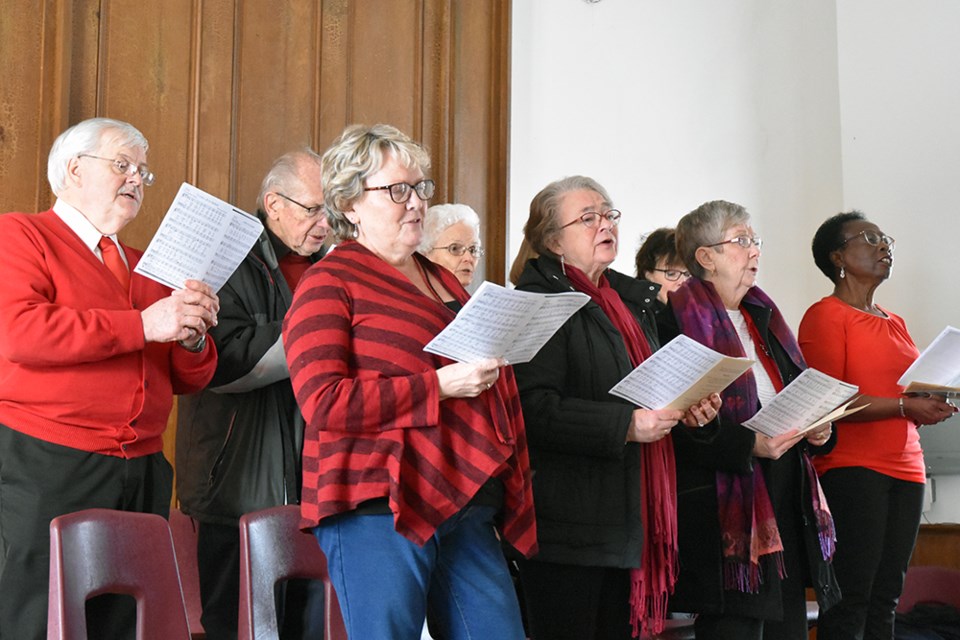The BWG Local History Association usually meets at the Bradford Public Library – but this year, decided to hold its December meeting in a more historic location. The association invited the community to join them in celebrating Christmas at the Auld Kirk Heritage Site, on Line 6.
The celebration coincided with the 200th anniversary of the founding of the Scotch Settlement, an area of West Gwillimbury Township that was settled by 14 families of Highland Scots, and three Irish families, in 1819. The Scots had first travelled to Lord Selkirk’s Red River Colony in what is now Manitoba, before fleeing bitter winters, crop failure and violence to come to Upper Canada.
This year also marks the 200th anniversary of the introduction of the Presbyterian faith to the area, and Reverend Dr. Dan Scott and the Choir of St. John’s Presbyterian Church were part of the Christmas celebration.
The Scotch Settlement families worshipped in their homes and barns, before building the first log church on the 6th Line in 1823. That church was replaced by a frame building, and finally by the brick Auld Kirk in 1869 – now designated by the Town of BWG as a heritage site.
The special meeting included a carol sing and a reading of the Christmas story by Rev. Scott – in English, from the St. James version of the bible, “because my Gaelic is not so great,” he said.
He was referring to the early Church of Scotland, which believed that all worship should be conducted in the 'language of heaven' – Gaelic – and that the only fit ‘instrument’ to praise God was the human voice.
Rev. Scott reflected on “psalms, hymns and songs of the spirit,” pointing out that not only would the settlers have sung in Gaelic, they would have done so unaccompanied, and would have been limited to the 150 psalms in the Scottish Psalter.
Those ranged from songs of praise to “bitter laments,” Scott said. They would have seen the Highland clearances as a “punishment of God,” but would also have found solace in “psalms that are a tremendous comfort, where God leads His people as a shepherd leads his flock.”
It was divisions over language and music, and the introduction of an organ, that led to a split in the local Presbyterian church, and the construction of the second West Gwillimbury church on Line 5. That church had an organ because, as Dr. Scott quoted Martin Luther, “Why should the Devil have all the good music?”
Music, he noted, is now firmly part of Presbyterian worship, in over 30 nations around the world.
“It’s quite remarkable to be here,” said Rev. Scott, to be filling the space of the simple 150-year-old building with harmonies and song, giving thanks and “Glory to God in the Highest… with gratitude in our hearts.”
History Association member Sam Lee, admitting that his only link with the Highland Scots was that he “danced the Highland Fling with Shirley Bowles when I was five years old,” saluted those early settlers, who endured such hardship.
Lee praised the tradition of the Pipes and Drums, recited part of “The Ballad of How MacPherson held the Floor” by Robert Service, and even twanged a few notes of ‘Old Macdonald had a farm' on the Jew’s Harp.
In the audience were members descended from the Scotch Settlers, including Cathy (Sutherland) Reid, and Ann Campbell, whose late husband Tom was also a descendant, and whose family had welcomed a special guest in 1964.
That guest was John Muir, Botanist, who went on to found the Sierra Club and the first National Parks system in the U.S., noted Robert Burcher.
Burcher came from Meaford to share some of his research into Muir’s two years in Upper Canada – which included a nine-month stay in West Gwillimbury with the Campbell family. While here, Muir explored the great “Holland Swamp,” and discovered an orchid that he named “Calypso borealis.”
Muir later described the discovery as one of the highlights of his career, an almost spiritual experience in the vast swamp. Burcher, who will be guest speaker at the May 2020 meeting of the BWG Local History Association, brought along a photograph of the actual Calypso orchid collected by Muir, pressed and preserved.
Burcher noted that Muir came from a joyless sect of Scottish Presbyterianism, as bleak as the American Puritans. For him, the visit to West Gwillimbury, among the more joyous residents of the Scotch Settlement, was an awakening and a “summer of glorious freedom.”
More than 50 people attended Christmas at the Auld Kirk, and joined the choir in singing favourite Christmas carols, from Little Town of Bethlehem to a rollicking version of Go Tell it on the Mountain. The afternoon ended with the harmonies of Silent Night.
“When you come in here and the church is empty, it looks kind of plain,” said association President Jan Blommaert. “You put a choir up here… Just perfect!”
She thanked everyone involved in Christmas at the Auld Kirk, and invited guests to stay for hot apple cider and cookies.
And she expressed one regret. “I wish George Jackson could have lived long enough to see this church open to the public,” Blommaert said. One of the earliest proponents for the preservation of the Auld Kirk, Jackson inspired the BWG Local History Association to take on the restoration of the Auld Kirk as a special trust.
The next meeting of the BWG Local History Association will be on the fourth Saturday in January, at the BWG Public Library and Cultural Centre.



